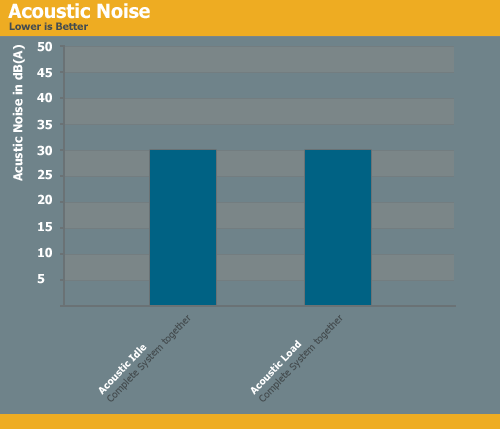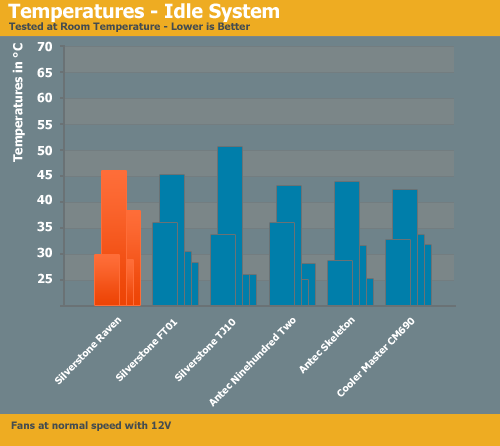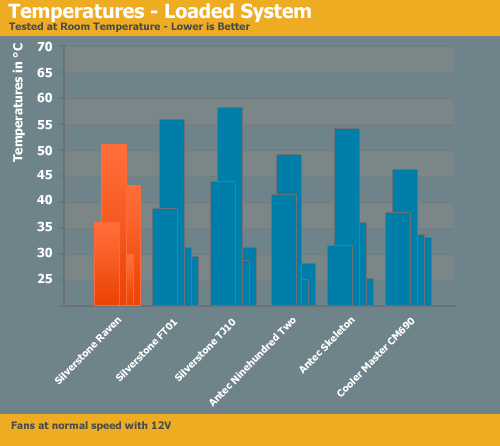Silverstone Raven: A New Concept in Case Cooling
by Christoph Katzer on February 6, 2009 4:00 AM EST- Posted in
- Cases/Cooling/PSUs
Performance Comparison
With everything installed, let's take a look at one of the more important aspects of any case: cooling performance and acoustic noise.

Even with everything installed -- which includes some rather noisy GPUs -- the net result is a very quiet system. It's noticeably quieter than the Silverstone FT01 with a difference of 5 to 8 dB.

Temperatures also look pretty good, but we need to compare this case with the competition to put things in perspective.


Note: The first column is the CPU temperature, the second represents the graphics cards, the third is for the hard drives, and the last one is the ambient temperature.
At idle, CPU temperature is a cool 30°C, which compares very favorably to other previously tested systems. (Note that we have some cases in the above charts that we haven't officially reviewed yet; these cases will be reviewed in the near future.) Load temperatures are similarly impressive, reaching just 36°C. Out of the tested cases, only the Antec Skeleton posts a better CPU result, but that's an open air case.
We expected better results from the graphics cards, but it appears the top cover restricts exhaust and thus hampers cooling. You can remove the top cover to improve the temperature results, but at the cost of marring the appearance. The large 180mm fan cools the hard drives nicely, keeping them at the same temperature in idle and load conditions.
All of the temperatures are good to very good, with one exception: ambient temperature. We were shocked by the ambient temperature as we expected much better results. It was 38°C at idle and 43°C at load, which is much higher than anything else we've tested so far. The temperature diode was directly below the CPU cooler at the height of the system memory, so it may simply have been caught in a dead spot where there wasn't much airflow. This is the same location we use in the other cases, but it could be that the motherboard orientation adversely affected airflow to this area. Still, we didn't feel we should change it as we wanted to stay consistent in our tests.










49 Comments
View All Comments
Th3Eagle - Friday, February 6, 2009 - link
I wonder what whould hapen if 1 or maybe even 2 12cm intake fans would be placed at the bottom of the window. Extra cold air intake would force all the hot air out of the top creating a flow over the mb of cold air.andrihb - Friday, February 6, 2009 - link
It occoured to me that most of the benefits here are achieved just by having the PSU at the bottom. Does anyone here have the Cooler Master Dominator case? The Bottom PSU configuration is great because you can keep most of your cable clutter at the bottom of the case, and need even shorter pci-e power cables than with this one. You need the case to be somewhat taller than average to have ample room for aftermarket video card coolers on SLI/XF setups though, else they will be uncomfortably close to the psu. Another neat thing is that you can decide which way the PSU faces, with the intake UP (inside the case) or down (drawing air from outside).aapocketz - Friday, February 6, 2009 - link
I would have liked to see tests with various fan speeds configured. Are the case fans not throttled, they only run at one speed?I would be concerned about dust, hopefully the air filters work well. Would this case work on carpet? May be interesting to put on a floor vent when the AC is running.
when it comes to air cooling you can do a lot of things but in the end it mostly comes down to volumetric replacement of air, without stalling out the airflow and creating dead zones. with this significant directional airflow, the actual order of components in the airflow path makes much less of a difference. I would have liked to see a stovepipe design without the motherboard rotation to compare.
This theory is even more true for watercooling as well. I had a system that was cooling the CPU, then chipset, then hard drives, and back to the radiator/pump. Reversing the direction of flow so the CPU was cooled last made negligible difference.
superkdogg - Friday, February 6, 2009 - link
It seems pretty reasonable that the issue with the temp would be that the graphics card exhause is being limited as you alluded to. If it's harder to get the warm air out, more is going to accumulate inside and the test was running 3 cards.It would be interesting to see the results run with the top off or modded to have black screens where it's currently solid plastic. Or maybe not that interesting, since for $240 you want something that performs awesome right out of the box.
CU - Friday, February 6, 2009 - link
Just wish it was cheaper. The cpu heatsink did catch my attention though. I have that same one setting on my X2. Nice to know I can use it on my next cpu also.beepboy - Friday, February 6, 2009 - link
"Even though this is a steal chassis with lots of plastic..."Steel :). Great looking case, but I'm still wary about water/accident that might just spill on top of the case...
thanks,
Beepboy
haukionkannel - Friday, February 6, 2009 - link
Guite interesting case. So this has the power in the bottom of the case like in Antec 180 series.When all the cables are in the top of case this can be good "under the table" solution, as lond as there is enough space above it.
I still like my P180, but this definitely is one that I may consider depending on the sound level. It would be nice to see some test in more "normal" configuration, but to any heavy user this seems quite ideal. 3 way sli and 7 harddisk and so low temperatus and sound level? Maybe if there would be more space to route the cables behind the mother board would be a nice feature to the revised edition of this case... och and an alumine variant to the rich boys ;-) or one with same idea, but a little bit more conservative appearance...
falchard - Friday, February 6, 2009 - link
I don't think the idea is actually that good. You have air coming in from the bottom, and going out the top. Sometimes different isn't always a good thing.The bottom intake will be limited because of the ground, and side intake really would not generate alot of airflow due to the angle it comes in at.
You have all the air flow through the PSU first which is one of the hottest parts on the machine, and now your just flowing warm air over the rest of your PC.
If this design had a descent chance at working, the bottom fans would be angled at 45 degrees and the PSU placed at the top of the case.
RagingDragon - Saturday, February 7, 2009 - link
I think the motherboard orientation has potential, but that the fan layout leaves alot to be desired - I agree completely that the bottom intakes are sub-optimal (to put it kindly). I'd recommend the following layout changes:1. Get rid of bottom intakes
2. Put a big intake fan in the standard bottom front case
location (i.e. under the hard drive trays)
3. Put two or more large intake fans on the side of the case,
above the power supply (blowing cool air on the graphics
cards and motherboard)
4. Enlarge the top exhaust fan to 140mm (port clusters are
about 140mm wide anyway)
5. Add an 8th expansion slot cut out to support support dual
slot graphics cards on motherboards with a PCIe-16 slot in
position #7 (i.e. on the leftmost edge), and also triple slot
graphics cards on more standard motherboards.
And personally, I think the case is hideous. I prefere simple, conservative case styling. But if it sells decently, no doubt Silverstone will offer variants using the same layout with different styling.
C'DaleRider - Friday, February 6, 2009 - link
If you really look closely at the photos provided, the PSU's exhaust is to the outside, so the power supply is NOT just taking cool air into it and then circulating it back into the case, which is the way almost EVERY case is set up....the psu takes in air from either outside or from inside the case and exhausts its now heated air directly to the outside......DUH!